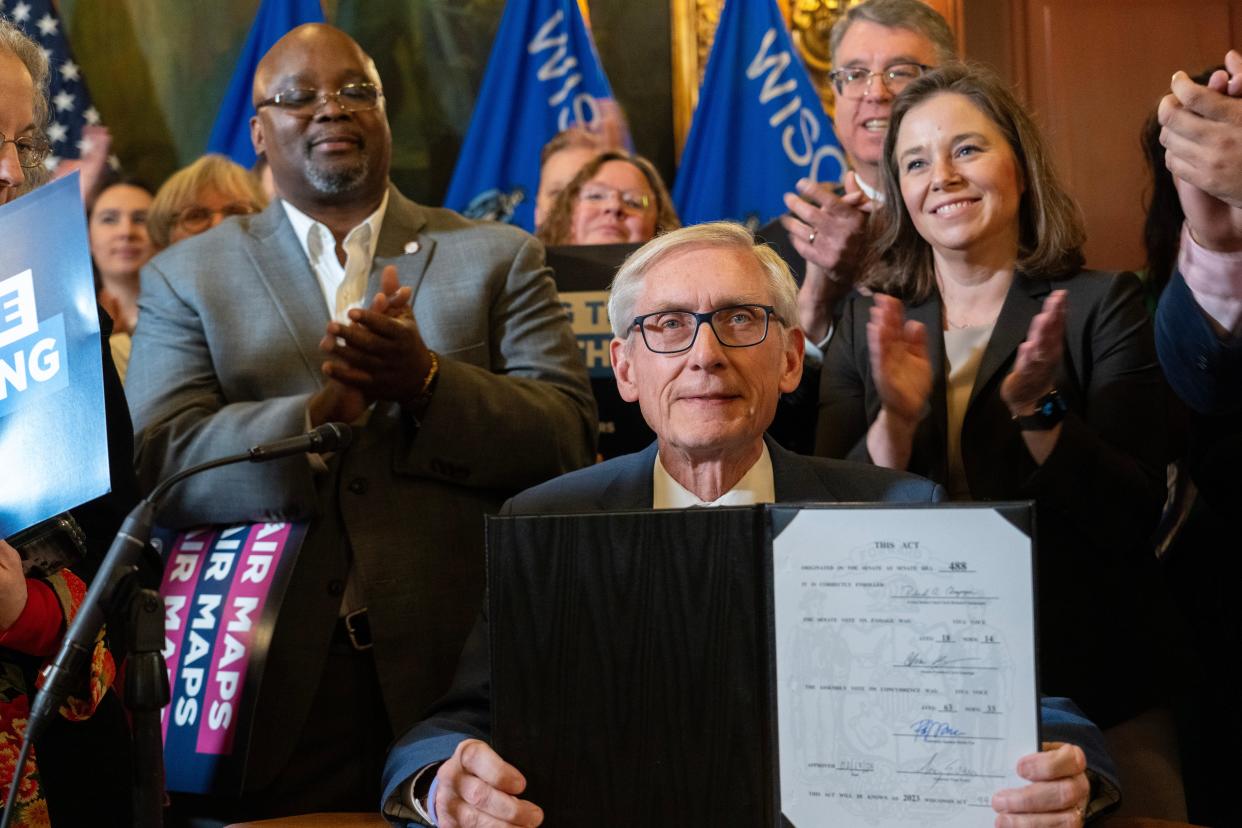New maps mark a transformational change in Wisconsin legislative elections

- Oops!Something went wrong.Please try again later.
Wisconsin politics was potentially transformed Monday when Democratic Gov. Tony Evers signed new maps that will end the Republican Party's long-lasting vise grip on the state Legislature.
The difference between the new maps and the old maps is staggering.
Here is one way to illustrate it.
Let’s assume for the sake of argument that every voter in Wisconsin voted the same way for the state Assembly as for governor.

In this hypothetical, the old maps would have generated a 60-39 majority for Republicans in the state Assembly in 2022, even though they lost the governor’s race by 3 points.
The new maps would have generated a 52-47 Democratic majority.
That is a swing of 13 seats in a 99-seat chamber. It is the difference between Republicans having a 21-seat edge and Democrats having a 5-seat edge.
There are many different ways to quantify the dramatic new state of play in Wisconsin, assuming these maps, now ratified by a Republican legislature and Democratic governor, survive any future court fights.
But when it comes to the nature of legislative elections here, the big picture is indisputable.
The old maps guaranteed very large GOP majorities even in terrible Republican years.
The new maps give Democrats a realistic chance to win legislative control (with one caveat I will explain below). They don’t significantly boost the number of competitive seats. But because they put legislative power in play, they make legislative elections consequential again. The new maps make the overall outcome contingent on the kinds of things that we normally think of as deciding elections: candidates, campaigns, conditions, voter turnout, swings in public opinion.
Moving forward, good election years for Democrats will generally produce Democratic majorities in the Legislature (and the same for Republicans). The majority party won’t be able to take its power for granted.
The last time that was true in Wisconsin was the 2010 election, nearly 14 years ago. The legislative maps that year were competitive, but a huge Republican wave (it was the year of the Tea Party) produced strong GOP majorities in both chambers and a GOP governor, Scott Walker.
With complete control of state government, Republicans enacted a highly gerrymandered map, meaning a map designed to minimize the number of Democratic-leaning seats, maximize the number of Republican-leaning seats, shrink the number of competitive seats, and remove virtually any uncertainty about which side would come out on top.
In the first election under that map, Republicans won 60 of 99 Assembly seats, despite losing the statewide vote for president that year by a whopping 7 points.
In every election that followed under that map — whether Republicans were winning or losing at the top of the ticket — they never won fewer than 60 Assembly seats.
A new map enacted before the 2022 elections was just as tilted, if not a little more so. Republicans ended up winning 64 Assembly seats.
Then the spring 2023 election produced a 4-3 liberal majority on the state Supreme Court. The new court overturned the maps, asked for new ones, and were on the verge of choosing among six submissions when GOP legislators last week approved the maps submitted by Evers because they feared the court would pick a map they disliked even more. (In a detailed analysis, my Marquette Law School colleague John Johnson described the differences between the Evers maps and three other Democratic-aligned maps before the court as “small but measurable.”)
So where exactly do the governor’s maps leave the two major parties?
One obvious way to measure this is to use recent statewide elections as a guide to the partisan makeup of the new districts.
Take for example, the most recent races for president (2020), governor (2022) and US Senate (2022). These contests were close and generated different partisan results. Democrats won the governor’s race by 3.4 points and won the presidential race by less than a point. Republicans won the U.S. Senate race by 1 point.
If you average the vote for these three high offices, seat by seat, you get a reasonable approximation of the partisan lean of every legislative district.
And you find that the state’s new legislative lines produce a roughly even playing field. In the Assembly, 49 seats lean Republican and 50 lean Democratic. In the state Senate, 16 seats lean Republican and 17 lean Democratic.
The partisan advantage is tiny enough in a handful of seats that neither party has a very meaningful advantage. For example, if you discount seats where one party’s advantage is less than 5 points, then 46 Assembly seats lean Republican, 45 lean Democratic and eight are competitive, based on these same three recent elections.
Another way to gauge this is to look at the makeup of the median seat: the 50th seat needed for an Assembly majority and the 17th seat needed for a state Senate majority.
The “tipping point” median seat in the Assembly has a three-tenths of a point Democratic lean under the new map, based on these same three elections, meaning it is essentially up for grabs.
The median or “tipping point” seat for the state Senate has a 1.6-point Democratic lean — making it slightly easier for Democrats to win than for Republicans.
If you used a different or larger set of elections to do this analysis, the results would look slightly but not fundamentally different. It’s a far more competitive landscape than before.
Why the Republicans will likely hold the Senate this fall
But just because Republicans are losing their lock on the Legislature does not mean they will lose their majorities this fall.
One huge reason is that state Senate elections are staggered: only 16 of the 33 state Senate seats (the even-numbered districts) will be on the ballot in 2024.
And Republicans start out this fall with a huge head start in control, because among the 17 odd-numbered seats that were up in 2022, the GOP won 12 and lost 5.
Those seats won’t be up again until 2026.
That means for the Senate to change hands this time, Republicans must lose all but 4 of the 16 Senate seats on the ballot this fall. And under the Evers map now in effect, six of those 16 districts have a strong GOP tilt. In other words, the GOP is almost certain to keep its state Senate majority until at least the 2026 election.
In this key respect, the Evers map was not the best map for Democrats among those submitted to the state Supreme Court.
For example, the map drafted by the Wright petitioners (a group of mathematicians and social scientists) was designed to put the state Senate in play this fall. Under that plan, 12 of the 16 Senate seats on the 2024 ballot would have a Democratic lean (instead of 10 under the Evers map).
The other reasons that Republicans could hang on to their legislative majorities in this or future elections are much more traditional ones. They could have a good election year. They could recruit better candidates. They could run better campaigns. They could have a better message. Their voters could be more motivated. They could win independents.
These are all things that haven’t really mattered that much for legislative control for more than a decade. They were the difference between Republicans having a massive legislative majority and a slightly less massive legislative majority.
Now they will be the difference between winning and losing.

Craig Gilbert provides Wisconsin political analysis as a fellow with Marquette University Law School's Lubar Center for Public Policy Research and Civic Education. Prior to the fellowship, Gilbert reported on politics for 35 years at the Journal Sentinel, the last 25 in its Washington Bureau. His column continues that independent reporting tradition and goes through the established Journal Sentinel editing process.
Follow him on Twitter: @Wisvoter.
This article originally appeared on Milwaukee Journal Sentinel: New maps mark transformational change in Wisconsin elections

